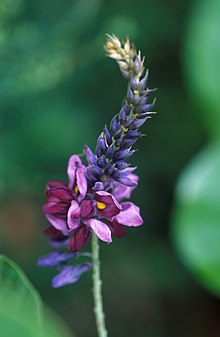豆科
| 豆科 化石时期:古新世–現今[1] | |
|---|---|
 | |
Kudzu (Pueraria lobata) | |
科学分类 | |
| 界: | 植物界 Plantae |
| 演化支: | 被子植物 Angiosperms |
| 演化支: | 真双子叶植物 Eudicots |
| 演化支: | 蔷薇类植物 Rosids |
| 目: | 豆目 Fabales |
| 科: | 豆科 Fabaceae Lindl.[2] (Leguminosae Jussieu, nom. cons.).[3] |
模式属 | |
蠶豆屬 Faba Mill., 1754(=Vicia L., 1753) | |
| 亞科[4] | |
| |
多样性 | |
| 730屬,19,400種 | |
 | |
| 豆科成員分布圖,主要分布於四類生物群系之中:熱帶雨林、溫帶、草原,以及沙地。[5] | |
異名 | |
| |
豆科(学名:Fabaceae,保留名:Leguminosae[6])植物屬於真雙子葉植物豆目,约有727属19,325种[7]。為被子植物中相當龐大的一科,占了已知開花植物物種的7%[8][9]。部分物種在經濟上具有重要地位,該科成員形態上包含喬木、灌木,也有多年生或一年生草本植物。該科成員最顯著的特徵是會結豆莢。成員具複葉及托葉。該科成員分布廣泛,為目前已知陸生植物中第三大科,僅次於蘭科及菊科。目前該科已知有765屬,約19,500餘種[4]。其中最大的五屬分別為黃芪屬(Astragalus,逾3,000種)、相思樹屬(Acacia,逾1000種)、槐蓝属(Indigofera,約700種)、豬屎豆屬(Crotalaria,約700種)、含羞草屬(Mimosa,約500種),這五大屬占了該科物種的四分之一。豆科也是非洲及美洲熱帶雨林和沙漠氣候中,最常見的科別[10][11][12][13]。系統分類學分析認為該科最接近同屬於豆目的远志科、海人树科,以及皂皮樹科[14]。
人類利用豆科植物已經有數千年的歷史,且與人類演化具有密切關聯[15]。豆科的作物包含大豆(Glycine max)、菜豆(Phaseolus)、豌豆(Pisum sativum)等等。
目录
1 語源
2 分类
3 描述
4 生态
5 系統分類學
6 參見
7 参考文献
8 外部連結
語源
豆科的學名「Fabaceae」來自其模式屬蠶豆屬(Vicia)(模式种救荒野豌豆 Vicia sativa L.)的异名「Faba」(模式种蠶豆 Vicia faba L.)。「Faba」於源自拉丁文,意指「豆」。「Leguminosae」是該科更早的學名,目前被視作仍然有效的保留名[6]。
分类
本科可分為六個亚科[16]:
蘇木亞科 Caesalpinioideae(包含含羞草亚科 Mimosoideae 例如:鳳凰木、黃槐、相思樹、合欢)。
紫荆亚科 Cercidoideae(例如:紫荆)
甘豆亚科 Detarioideae
摘亚木亚科 Dialioideae
山姜豆亚科 Duparquetioideae
蝶形花亚科 Faboideae(例如:各种豆类)。
描述

白葉肥皂莢的果實。
豆科成員形態多樣,從喬木(如樹王木)到一年生草本植物皆有,其中最大宗者為多年生草本植物。花序多樣,花朵有一短托杯及單一雌蕊,雌蕊柄短小。在受精後才會結果。
豆科與其它科区分的特点是其果实为本科独有的荚果,由一心皮发育而成,成熟时果皮沿背缝线和腹缝线开裂。
荚果通常由2片果瓣组成,1室,种子生在腹缝线上。荚果的形状、大小及荚瓣质地变化很大。如草木犀属,直径只有3~4毫米,而生长在热带中的榼藤,木质荚果可长达1米。有些有翅,如老虎翅属的果顶端有一长圆形薄翅;紫檀荚果周围被一圈阔翅所绕;盾柱木属和黄檀属荚果都具有翅。鱼鳔豆的膜质荚瓣,充气呈泡状,借风力传播;猪腰豆的木质荚瓣厚达2厘米以上。苜蓿属和猴耳环属的一些荚果呈螺旋状盘卷。腊肠树的荚果像一根圆柱形的棒。相思子的荚果里面藏有半红半黑、鲜艳的种子,种皮坚硬有光泽。
豆科植物的一个重要特点是绝大部分在根系上具有共生的根瘤菌,可以将大气中的氮固定到土壤中,从而提高土壤的肥力。
生态
豆科为虫媒,主要为蜜蜂传粉,少数靠蚂蚁、蛾类或甲虫等传粉。含羞草亚科和云实亚科的一些种类在叶柄、叶轴上带有分泌腺体以吸引蚂蚁;金合欢属有些种类茎上有大、中空的刺,供蚂蚁停留;决明属植物有顶孔开裂的基着花药,适应蜜蜂摇动花药取花粉;云实属植物花丝基部被毛,遮盖雌蕊和花托口部,避免自花授粉。
系統分類學
| 豆目 |
| |||||||||||||||||||||||||||||||||||||||||||||
參見
- 豆類
参考文献
^ Wojciechowski, M. F.; Lavin, M.; Sanderson, M. J. A phylogeny of legumes (Leguminosae) based on analysis of the plastid matK gene resolves many well-supported sub clades within the family. American Journal of Botany. 2004, 91 (11): 1846–62. PMID 21652332. doi:10.3732/ajb.91.11.1846.
^ Angiosperm Phylogeny Group. An update of the Angiosperm Phylogeny Group classification for the orders and families of flowering plants: APG III (PDF). Botanical Journal of the Linnean Society. 2009, 161 (2): 105–121 [4 February 2014]. doi:10.1111/j.1095-8339.2009.00996.x.
^ Watson L.; Dallwitz, M. J. The families of flowering plants: Leguminosae. 2007-06-01 [9 February 2008].
^ 4.04.1 Azani, Nasim; Babineau, Marielle; Bailey, C. Donovan; Banks, Hannah; Barbosa, Ariane R.; Pinto, Rafael Barbosa; Boatwright, James S.; Borges, Leonardo M.; Brown, Gillian K. A new subfamily classification of the Leguminosae based on a taxonomically comprehensive phylogeny The Legume Phylogeny Working Group (LPWG). Taxon. 2017-02-22, 66 (1): 44–77. doi:10.12705/661.3.
^ 引用错误:没有为名为Schrire2的参考文献提供内容
^ 6.06.1 International Code of Nomenclature for algae, fungi, and plants. Article 18.5 states: "The following names, of long usage, are treated as validly published: ....Leguminosae (nom. alt.: Fabaceae; type: Faba Mill. [= Vicia L.]); ...
When the Papilionaceae are regarded as a family distinct from the remainder of the Leguminosae, the name Papilionaceae is conserved against Leguminosae." English pronunciations are as follows: 英語 /fəˈbeɪsi, -siˌaɪ, -siˌeɪ, -siˌi/; 英語 /ləˌɡjuːməˈnoʊsi/; and 英語 /pəˌpɪlioʊˈneɪsiˌi/.
^ ed. by Gwilym Lewis. Legumes of the world 1st ed. Richmond: Royal Botanic Gardens, Kew. 2005: 1–577. ISBN 978-1900347808. 引文格式1维护:冗余文本 (link)
^ 引用错误:没有为名为Judd2002的参考文献提供内容
^ Magallón, S. A., and Sanderson, M. J.; Sanderson. Absolute diversification rates in angiosperm clades (PDF). Evolution. 2001, 55 (9): 1762–1780. PMID 11681732. doi:10.1111/j.0014-3820.2001.tb00826.x. (原始内容 (PDF)存档于19 October 2013). 已忽略未知参数|df=(帮助)
^ Burnham, R. J.; Johnson, K. R. South American palaeobotany and the origins of neotropical rainforests. Philosophical Transactions of the Royal Society B: Biological Sciences. 2004, 359 (1450): 1595–1610. PMC 1693437. PMID 15519975. doi:10.1098/rstb.2004.1531.
^ Doyle, J. J., J. A. Chappill, C.D. Bailey, & T. Kajita. 2000. Towards a comprehensive phylogeny of legumes: evidence from rbcL sequences and non-molecular data. pp. 1 -20 in Advances in legume systematics, part 9, (P. S. Herendeen and A. Bruneau, eds.). Royal Botanic Gardens, Kew, UK.
^ Kajita, T.; Ohashi, H.; Tateishi, Y.; Bailey, C. D.; Doyle, J. J. rbcL and legume phylogeny, with particular reference to Phaseoleae, Millettieae, and allies. Systematic Botany. 2001, 26: 515–536. JSTOR 3093979.
^ Wojciechowski, M. F., M. Lavin and M. J. Sanderson; Lavin; Sanderson. A phylogeny of legumes (Leguminosae) based on analysis of the plastid matK gene resolves many well-supported sub clades within the family. American Journal of Botany. 2004, 91 (11): 1846–1862. PMID 21652332. doi:10.3732/ajb.91.11.1846.
^ Angiosperm Phylogeny Group [APG]. An update of the Angiosperm Phylogeny Group classification for the orders and families of flowering plants: APG II (PDF). Botanical Journal of the Linnean Society. 2003, 141: 399–436. doi:10.1046/j.1095-8339.2003.t01-1-00158.x.
^ Burkart, A. Leguminosas. In: Dimitri, M. 1987. Enciclopedia Argentina de Agricultura y Jardinería. Tomo I. Descripción de plantas cultivadas. Editorial ACME S.A.C.I., Buenos Aires. pages: 467-538.
^ .mw-parser-output .smallcaps{font-variant:small-caps}.mw-parser-output .nocaps{text-transform:lowercase}
Legume Phylogeny Working Group 2017. A new subfamily classification of the Leguminosae based on a taxonomically comprehensive phylogeny. Taxon 66(1): 44–77. doi:10.12705/661.3 Full text PDF
外部連結
维基物种中的分类信息:豆科 |
维基共享资源中相关的多媒体资源:豆科 |
Leguminosae at The Plant List
Leguminosae at The Families of Flowering Plants (DELTA)
Fabaceae at the Encyclopedia of Life
Fabaceae at the Angiosperm Phylogeny Website
Fabaceae at the Tree of Life Web Project
Fabaceae at the online Flora of China
Fabaceae at the online Guide to the Flora of Mongolia
Fabaceae at the online Flora of Zimbabwe
Fabaceae at the online Flora of Western Australia
Fabaceae at the online Flora of New Zealand
Leguminosae at the International Legume Database & Information Service (ILDIS)
Fabaceae at Flowers in Israel
豆科Fabaceae 藥用植物圖像數據庫 (香港浸會大學中醫藥學院) (中文)(英文)
黃豆苷元 Daidzein 中草藥化學圖像數據庫 (香港浸會大學中醫藥學院) (中文)(英文)
| ||||||||||||||||||||||
|
